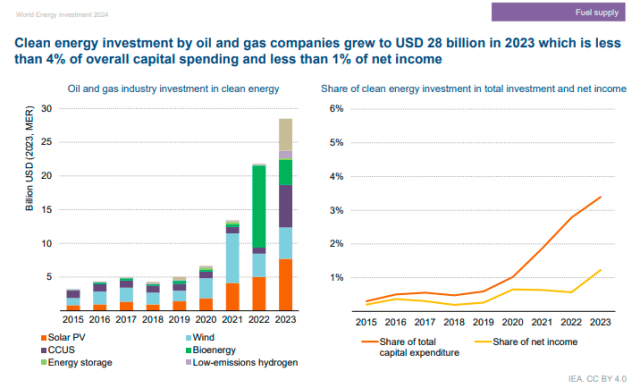Oil and gas companies have invested $28 billion into clean energy in 2023, achieving 30 percent increase from 2022 levels, according to IEA report.
The growth in clean energy investment by oil and gas companies was well below the 65 percent jump seen from 2021 to 2022. Inflationary environment, supply chain issues for some renewable projects, change in company strategies were the main reasons for the revision in growth.
Mergers and acquisitions completed in 2023 comprised just under half of total clean energy investment by the oil and gas industry, the report said.
Deals focusing on clean energy
The largest transactions included: ExxonMobil’s acquisition of Denbury’s CCUS network for $4.9 billion, which raises ExxonMobil’s CCUS capacity to over 100 Mt CO2 across its refining, chemicals, and enhanced oil recovery businesses; TotalEnergies’ $1.6 billion takeover of Eren Re, a renewable energy company, and Occidental’s $1.1 billion purchase of CarbonEngineering, a direct air capture (DAC) business. The ExxonMobil and Occidental deals together comprised the bulk of the industry’s $6 billion worth of investments in CCUS in 2023.
Investment in solar PV and wind projects
Investment in solar PV and wind projects comprised more than 40 percent of total clean energy spending by the oil and gas industry in 2023.
This includes more than $2.7 billion in investment by Equinor, $2.2 billion by TotalEnergies and $1.8 billion by Repsol. These three companies accounted for around 45 percent of total investment in renewables by the oil and gas industry.
Despite announced cancellations and divestments in offshore wind projects, investment remained substantial in 2023. Equinor invested nearly $1.6 billion in offshore wind in 2023. Two other recent projects – by BP in Korea and TotalEnergies in the United States – each involve around $2.5 billion worth of investment.
Capital expenditure in electrolysers reached a new high of almost $1 billion in 2023. Despite increasing policy support, the investment environment for low-emissions hydrogen remains fragile, mainly because of uncertainty about demand and the price that consumers will be willing to pay for low-emissions hydrogen.
Other areas of increasing interest include EV charging infrastructure, enhanced geothermal systems and lithium extraction from brine.
Clean energy investment by NOCs rose to more than $1.5 billion in 2023, representing around 5 percent of total clean energy spending by the oil and gas industry. Petronas, Sinopec, and Saudi Aramco led the NOC investments, which were mostly focused on solar PV and low-emissions hydrogen. Overall, the share of clean energy in total capital investment rose only marginally from 2022 levels.
Solar PV and wind projects continue to offer attractive investment prospects, despite profitability challenges in the manufacturing business. Renewable utility profitability is slowly returning to prepandemic levels, with returns on invested capital (ROIC) increasing by one-third in 2023 from a year earlier, thanks to falling solar and wind costs. ROIC is notably more stable compared to the volatility of oil and gas companies in recent years. Average cost of capital for renewable power firms has increased slightly in recent years, now hovering at around 7 percent of market value.
Global energy investment is set to exceed $3 trillion for the first time in 2024, with $2 trillion going to clean energy technologies and infrastructure. Investment in clean energy has accelerated since 2020, and spending on renewable power, grids and storage is now higher than total spending on oil, gas, and coal.
Upstream oil and gas investment is expected to increase by 7 percent in 2024 to reach $570 billion, following a 9 percent rise in 2023. This is being led by Middle East and Asian NOCs, which have increased their investments in oil and gas by over 50 percent since 2017, and which account for almost the entire rise in spending for 2023-2024.
Baburajan Kizhakedath

